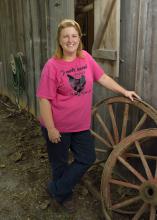Information Possibly Outdated
The information presented on this page was originally released on October 20, 2017. It may not be outdated, but please search our site for more current information. If you plan to quote or reference this information in a publication, please check with the Extension specialist or author before proceeding.
Dyess adapts to maintain success on family farm
WAYNESBORO, Miss. -- In three days, Teresa Dyess shifted her business focus from produce to poultry.
The change began two years ago with an offhand remark from her husband, Joe Dyess.
“He told a broiler grower in Wayne County we wouldn’t mind building pullet houses because we wanted to diversify our farm,” she said. “We didn’t think any more about it, and then the next day a poultry processor called and offered us a contract. A banker came the next day, and everything fell into place.”
Lanette Crocker, coordinator for the MSU Extension Service in Wayne County, said Teresa Dyess’ adaptability has helped her maintain success through the farm’s transition.
“Teresa is a hard-working, resilient producer, and she and Joe are a good example of a family keeping a small farm going,” Crocker said. “They work together and have been flexible in changing what wasn’t working. They’ve also helped our 4-H’ers by volunteering and participating in fundraisers.”
The Dyesses had farming backgrounds before they married. Dyess Farms is a third-generation farm started by Joe Dyess’ grandparents in the early 1900s. Growing up, Teresa Dyess and her four siblings helped their parents take care of their large family garden, cows and horses.
Joe Dyess, now the District 2 supervisor in Wayne County, was growing corn on the family farm when his wife left her office job with a gas company about 10 years ago to join him. As a team, they swapped corn for produce in 2010, beginning with a small patch of strawberries. It escalated until they had 6,000 tomato plants. They also grew squash, cucumbers, peas and peanuts.
Diminishing returns in successive years prompted them to consider other agricultural options.
“Deer got us one year, rain got us the next, and then a flood got us the year after that,” she said. “We had hired our neighbor’s children early on, but they got older and are doing their own thing now. Help became slim, and one person couldn’t do it, so we decided to build chicken houses.”
Now, the Dyesses raise chicks in two poultry houses from infancy until they are ready to go to an egg farm. Both houses are divided into three pens. Two of the pens have 14,000 hens, and the other contains 3,500 roosters. Augers outside the pens move feed on chains inside the houses into feed pans. The operation raises more than 100,000 chicks a year.
“When we first get the chicks, we’re out there from 6 in the morning until nighttime, and we hand-feed water to more than 60,000 chicks for 10 days,” she said. “After that, we get up at 5 every other day and run feed lines into the houses. We swap with the processor every 21 weeks and start over again.”
While the around-the-clock nature of her newest venture is challenging at times, Teresa Dyess is pleased to be making a living doing what she enjoys most.
“I’m an outside person,” she said. “It’s hard for me to sit behind a desk. I like going out there, walking through the rows of chickens and watching them grow.”
For more information on Women for Agriculture, go to http://mswomenforag.org/.






